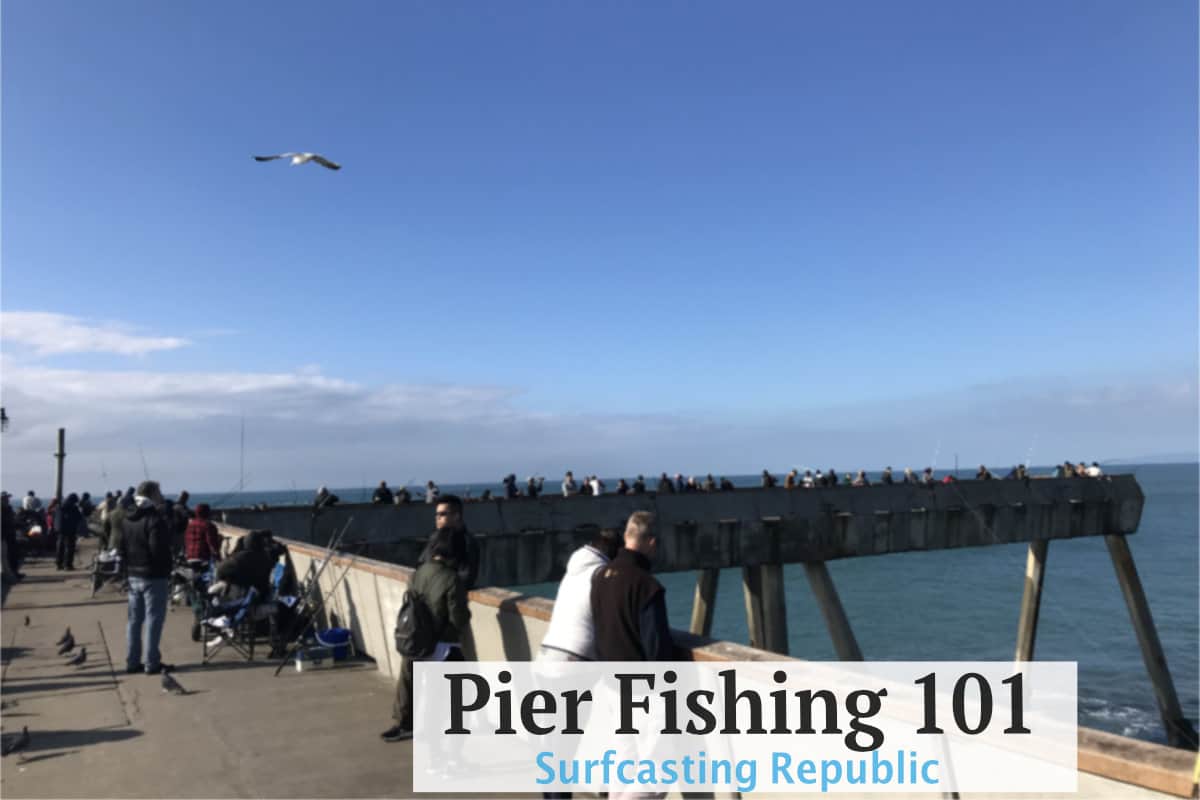Pier fishing is one of the best ways to get introduced to saltwater fishing, especially since you don’t even need a fishing license to fish off of most public piers, and they usually have tackle equipment and bait available on site. But how do you fish from a pier?
You need to know what kind of species you’re going after. Then gather all the right tackle and pieces of equipment you’ll need for pier fishing. Must have different types of baits to present, you also have to learn the rules and regulations of pier fishing.![]()
This ultimate beginner’s guide will explain the following:
- Supplies needed for pier fishing
- Different kinds of bait used for pier fishing
- Tackle and lures to use for pier fishing
- Types of Fish you can catch while pier fishing
- Optimal weather and water conditions for pier fishing
- Best times of day and year for pier fishing
- Pier fishing etiquette
- Tips for pier fishing
It may seem like a lot of information to take in at once, but if you read through this guide carefully, you’ll know everything you need to know about how to get started pier fishing by the time you’re done. Read on to find out more about this centuries-old technique and how to do it.
History of Pier Fishing
Piers have been built for hundreds of years for everything from handling cargo to leisure activities. One of the main reasons public piers are used in many places is to access deep saltwater fishing that beach anglers without a boat would otherwise not be able to reach.
When learning how to fish in saltwater, many people begin on piers because, in most places, they don’t require a fishing license![]() (unlike fishing on a public beach).
(unlike fishing on a public beach).
Some piers often have tackle equipment for both purchase and rent so that you can show up to a pier empty-handed, and as long as you can afford to pay, you can start fishing with no equipment at all.
Pier fishing![]() is also a good option for fishing when current and weather conditions (such as riptides) make surf fishing dangerous or unproductive.
is also a good option for fishing when current and weather conditions (such as riptides) make surf fishing dangerous or unproductive.
Pier fishing is also a way to catch more substantial types of saltwater game fish that prefer deep water rather than the surf zone.
These days many oceanside communities have a public pier access point nearby, so it’s possible to pier fish from coastlines all over the world.
Advantages of Pier Fishing
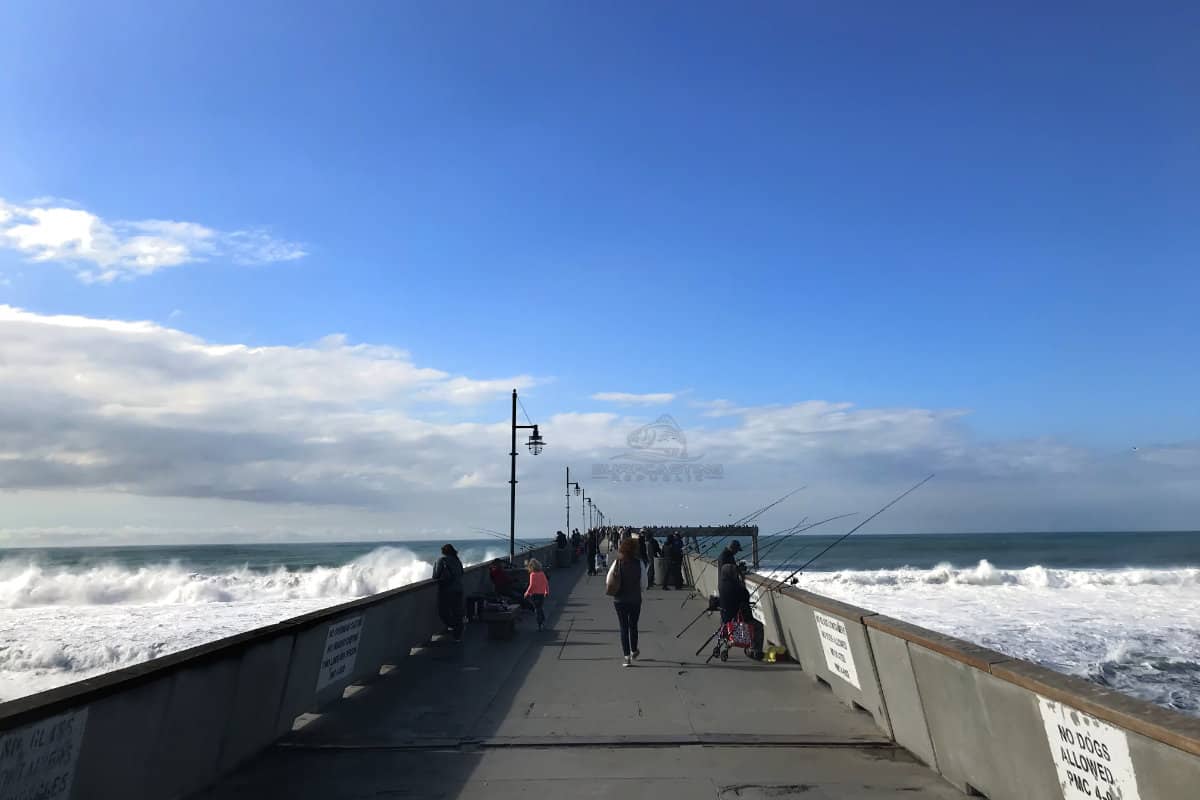
Some people may assume that the only people who would consistently use a public pier for fishing are kids, older people, and those who otherwise don’t have access to a boat.
While these groups do visit public piers, seasoned anglers know that a pier can be one of the best places to catch fish consistently even when you’re not getting bites on the shore.
Here are some of the advantages that pier fishing provides:
- Good fishing even in rough weather: While rough surf and choppy seas may keep many anglers with a boat out of the water. Piers offer a sturdy, steady location to fish from in weather that might not be suitable for boats, but it happens to be good feeding weather for fish.
- No special gear necessary: Most of the essential equipment needed for pier fishing is available on-site at many piers, such as rod rentals or bait shops. This means that even if you don’t own any fishing equipment, you can usually secure enough equipment at the pier to go fishing.
- Camaraderie: Pier fishing is a great community activity, and regular pier fishers learn to recognize and trade advice or compliments. Pier fishing is a fun way to get more involved with like-minded people who also enjoy saltwater fishing. Even if you don’t talk to other anglers on the pier, you can still feel less when fishing in the company of others.
- Amenities provided: Along with bait shops and small convenience stores that offer snacks for humans and fish alike, many longer piers that cater to both tourists and anglers also provide basic amenities such as bathrooms and fish cleaning stations.
- No boat, no boat-related expenses: Buying a saltwater fishing boat is expensive enough in and of itself. But when you throw in the cost of maintenance, storage, and fuel, pier fishing is much more economical than fishing from a boat, either your own or a rental. And you can catch large fish just as well from a pier as you can from a boat.
- No fishing or boating license required: Owning a fishing boat requires a boating license, and surf fishing usually requires a fishing license. On a public pier, however, you don’t need either one. This makes pier fishing pretty much the most accessible entry point to fishing in either saltwater or freshwater.
- Fish-like piers: Many species of fish are attracted to piers and docks because of the shelter and food sources these human-made structures provide underwater. Not only do game fish get the benefit of hunting baitfish that hang around beneath a pier’s structure, but they also get access to discarded bait and another chum.
Disadvantages of Pier Fishing
As you can see, there are many reasons as to why you would want to fish from the pier. While fishing from the pier is excellent, there are a few disadvantages to be aware of.
Here are a few possible disadvantages of pier fishing that you might want to consider:
- Space is limited: There is only so much space on a pier, and if there are a lot of people out enjoying it and the fishing opportunities it can provide, then your options might be much more limited. Some piers are larger than others, but on a busy weekend, finding a spot can sometimes be challenging.
- Cannot chase the fish: While it is true that many species of fish are attracted to structures such as piers, there are days when there seem to be no fish around. When that happens, you cannot just try a different area and are restricted to what you can fish from the pier. Moving areas to find where the fish are hanging out is a basic tactic for successful fishing, but this can be much more difficult when fishing from a pier.
- More competition: Most of the time, you will not be the only angler on the pier. If there are a lot of anglers out fishing, you could easily find yourself fishing elbow to elbow with other fishermen. This can, at times, be a little frustrating and disheartening, but fishing is a great sport enjoyed by many, and piers are a great place to fish. So, expect a little competition!
Related: How To Surf Fish For Striped Bass?![]() If you want to learn how to catch striped bass from the surf, click the link.
If you want to learn how to catch striped bass from the surf, click the link.
Supplies for Pier Fishing
One of the most convenient things about pier fishing is that piers often feature a fishing station designed around casual or amateur anglers.
Most of the Tackle, bait, and gear you’ll need to go fishing can be either rented or purchased at the shop.
Here are some of the necessary supplies you’ll want to bring pier fishing:
- Saltwater rod and reel
- Tackle and lures (in a tackle box preferably)
- Pliers
- A sharp knife
- A catch net (optional, but an excellent idea)
- A folding chair (also optional, but you’ll be glad you brought it)
- Extra spool of fishing line
- Live bait in bait bucket with aerator and net (if using live bait)
- Sunscreen
- Water and snacks
- Cooler to store your catch
Some of these supplies, such as rods, lures, and bait, can be procured on-site at many fishing piers, which often feature a tackle and bait shop at their entrance. Some piers may charge a small fee for access at this same spot.
Renting equipment might be a good option for first-timers who aren’t sure whether they’ll enjoy saltwater fishing or not, but for those who want to progress in the hobby, acquiring your own rod, reel, and Tackle will be a much better choice.
Tackle And Equipment for Pier Fishing
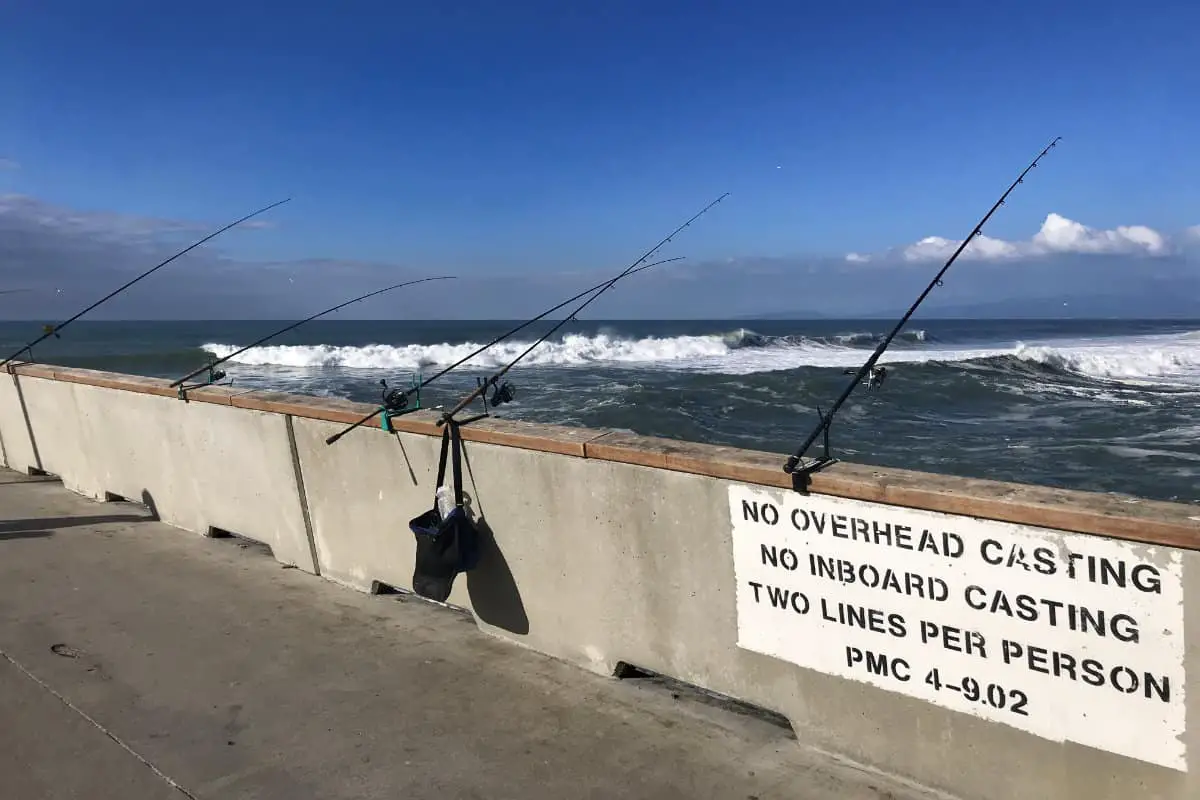
Using heavier Tackle while pier fishing (especially the further you go out onto a pier) is usually a good idea since the further out to sea you’re casting, the more likely you might hook something large like a shark or grouper.
Fishing Rod
Because of the wide range of potential catch when fishing off of a pier, there is no single best option when it comes to rod choice.
A rod that is strong enough for larger fish like sharks doesn’t give the sensitivity needed to feel bites from smaller catches. There are many factors to consider when buying a rod.
Below, I will talk about the four main considerations when buying a rod: length, power, action, and material.
It is best to start with smaller fish if you are just getting into pier fishing, which means keeping your line closer to the pier. The farther out you go, the bigger the fish will get.
However, keeping your line close does not mean a zero chance of hooking something bigger, so you will need a durable rod.
One quick note before we continue, I’ll recommend that you stick with a spinning rod when starting with pier fishing, rather than a casting rod.
Related Article: What’s the difference of baitcasting and spinning rods?
They are easier for beginners, and you will get fewer tangles on your line.
If you had to get just one rod for your pier fishing adventures, I would recommend this:
- Size: 7 to 10 foot
- Power: medium/medium-heavy
- Action: moderate/moderate-fast
- Material: Fiberglass
The Size
The size of the rod refers to its length, which determines the accuracy of your casting. Longer rods give more accurate casts.
If you want to start small and catch some baitfish, you will want to stick with a 7-foot rod. You won’t need to cast your line far out.
In general, you can just drop it off the end of the pier and be in the good territory to catch baitfish with a jigging rig.
The next step up would be catching medium-sized fish, for this, you will want to be cast a bit farther out, and with some accuracy, so you want at least an 8-foot rod.
Finally, if you are going for those bigger fish, a 8 to 10 foot rod medium heavy to heavy is your best bet.
The Power a Rod
The power of a rod rates how much pressure is needed to bend the rod. For pier fishing, you don’t want to go below a medium-light rating, anything else will flex too much and likely be broken when you get nibbles from a larger catch.
For those who want to stick close to the pier and catch, baitfish, a medium-light rod will do the trick.
For medium-sized fish, you can use a medium-heavy rod. When you get into the bigger ocean catches, you will need a heavy rod.
The Action of A Rod
The action of a rod tells you where along the length of it, you will see flexion.
Fast action rods only bend near the top third of the rod; this gives improved sensitivity, allowing you to feel every nibble.
Slow rods bend down to the bottom third near the reel. This is great if you want to cast light lures great distances.
For pier fishing, you won’t need to send small light lures flying a great distance, so stick with a rod with moderate to moderate-fast action.
This type of action will allow you to feel when even the smaller fish strike the line.
The Rod Material
The two materials you will see for most rods are fiberglass and graphite.
In general, you want to stick with a graphite rod; they are lighter, which allows you to cast more without getting tired. They are also more powerful (meaning they can handle more weighty fish).
Finally, graphite is also the more expensive of the two, but the rod will have less chance of breaking, less chance of breaking, meaning that you will have to replace the rod.
Fiberglass rods tend to be slower action meaning they bend along the whole length of the rod.
There are also composite materials, but these are higher-end rods with higher-end price tags. For beginners, a graphite rod is the best place to start.
Reel For Pier Fishing
There are two types of reels you will need to pick between the spinning![]() reel and the (bait)casting reel.
reel and the (bait)casting reel.
Note that your reel and rod type have to match; if you have a spinning rod, you need a spinning reel. Mixing them can cause damage to your equipment.
For small- to the medium-sized game, you should stick with a spinning reel![]() . These types of reels are great for beginners as the nature of their setup means you are less likely to tangle your line.
. These types of reels are great for beginners as the nature of their setup means you are less likely to tangle your line.
However, these reels cannot handle the heavy line needed if you are going to catch big game fish.
For the heavier game fish, you can go to a casting/baitcasting reel. These reels can be loaded with heavier braided lines that can reign in the big catch.
A casting reel and rod, in the hands of an experienced angler, can also cast your bait further, where you will find those bigger fish.
Line For Pier Fishing
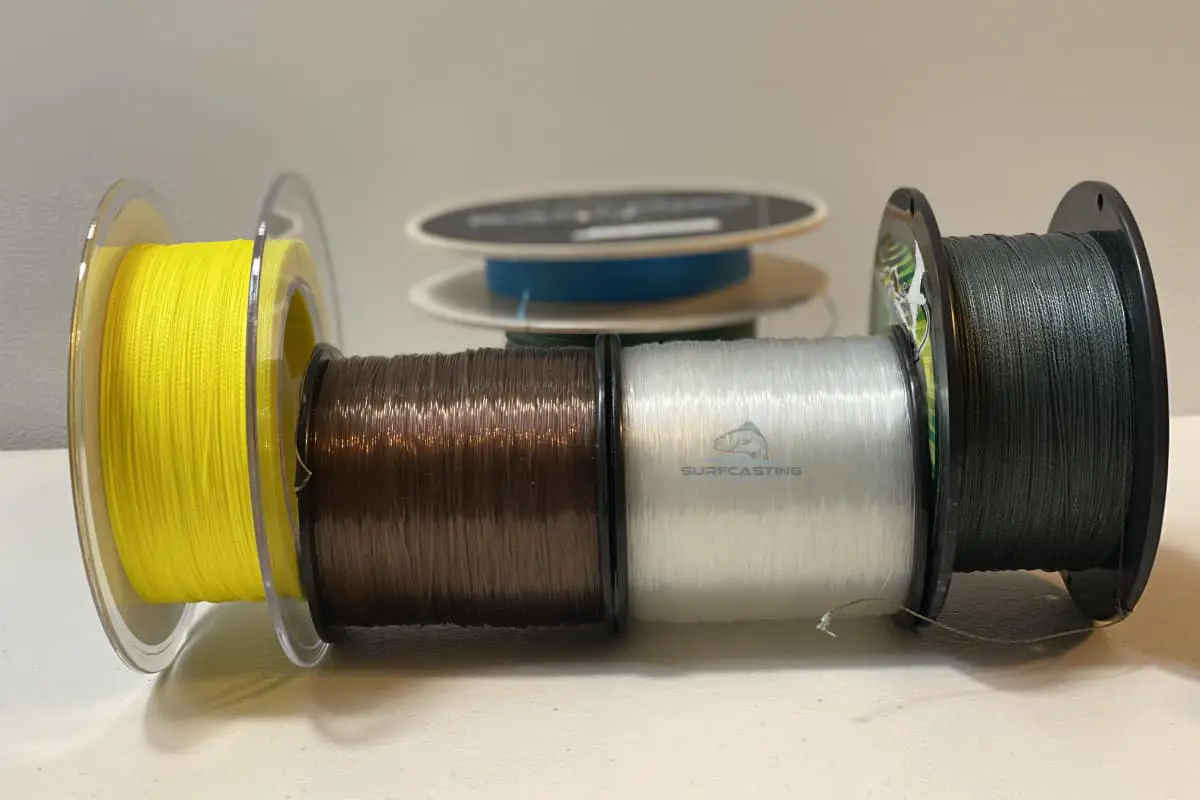
When choosing your fishing line, you will have to choose between monofilament, braided![]() , and fluorocarbon
, and fluorocarbon![]() . Let’s take a look at the attributes for each type of line.
. Let’s take a look at the attributes for each type of line.
- Monofilament(mono): most common, more durable than the braided line, good stretch.
- Braided: stronger per diameter than mono, less durable than mono, no stretch.
- Fluorocarbon: new material, has the same light refraction as water, making it nearly invisible when it is in the water, highest abrasion resistance, stiffest material.
Check this article where I covered the pros and cons of each fishing line.![]()
For beginners, you want to stick with the braided or monoline for pier fishing.
Fluorocarbon![]() is better suited when running a leader line. It is harder to work with because of its stiffness, and it breaks down quickly in sunlight and saltwater.
is better suited when running a leader line. It is harder to work with because of its stiffness, and it breaks down quickly in sunlight and saltwater.
I recommend a monoline for first-timers; this will give you the strongest and easiest line to start.
If you find you need a slimline profile with greater strength, you can switch to braided line down the road.
You can also start with a braided line if the pier you fish from is free from any hazards, such as rocks.
The fishing line also comes in many different colors![]() . These are separated into two broad categories, high-visibility and low-visibility.
. These are separated into two broad categories, high-visibility and low-visibility.
High-vis line is excellent for anglers, especially those running multiple rods, as they can better see it.
If you have many rods going, you can get different colors for each rod.
That way, you can tell which rod is getting action at a glance.
Lines that are easy to see are also better for those around the pier.
Swimmers, boaters, and even birds will be able to see your line easier and are less likely to get tangled up in it.
Low-vis line is better for hiding from the fish. This includes colors that blend in with the water, either green or blue; in muddy conditions, brown is also used.
Clear lines are also produced and are considered low-vis.
As a beginner, you should go with a high-vis option.
The high visibility will allow you to see when your line gets bites and help avoid accidents with boaters and swimmers.
Large fish can strike a pier lure at any time just as easily as a panfish can.
So, make sure you’ve got gear that can handle a big and aggressive fish, or you’ll risk losing the whole shebang if you get a powerful strike that can potentially rip a lighter rod from your hands or snap the line.
Fishing Cart
These carts are convenient if you’ve got more gear than you can carry. They will help you get everything to and from the pier, including that cooler full of fish (hopefully)!
There are a few things to consider in a fishing cart.
If you are taking your cart over sandy, rocky terrain with broken seashells and other debris, you want a cart with heavy-duty wheels.
Some good options include poly or pneumatic plastic wheels. They are highly resistant to potential punctures from sharp rocks and seashells.
Many piers have direct access from the street or parking lot, and thus, you may never need to take your cart over rough terrain.
In this case, you can likely get a cart that has less durable wheels.
You also want to look at the carrying capacity of the cart. If you are catching bigger fish, get a cart that can accommodate a large cooler and can carry more weight.
If you are catching smaller fish, then this factor is less important.
Some fishing carts are collapsible. This is important if you have a smaller vehicle or do not have room to store the cart at home full-size.
If space is an issue, get a collapsible cart. They come in heavy- to light-duty varieties like their non-collapsible counterparts.
Don’t Forget Your Landing Net
Once you have caught a fish, you need to bring it up to the pier. The first part of that job can be done by reeling the fish in.
However, once you get closer, it is best to have a net with which to scoop up the fish. This is much easier than trying to grab a thrashing fish with your bare hands.
A few things to consider when selecting your net are the hoop size, the net material, and the handle length and material.
The hoop size is determined by the length of the fish you want to catch. If you are a multi-species angler, you will need multiple sizes of nets.
As you want to start with smaller fish as a novice, you should get a net with a medium-sized hoop and a small mesh.
This size of hoop and mesh will fit a medium to small catch, and the smaller mesh will mean the smaller baitfish won’t escape through the meshing.
Mesh material is usually coated or uncoated nylon.
Coated nylon is the best, albeit slightly more expensive option.
The coating is better on the fish as it won’t scrape away scales and protective slime, especially crucial for catch-and-release fisher.
The coating also prevents your hooks from puncturing the netting and getting caught. Piers are generally pretty tall structures, so you do not want a short-handled net.
Another option for pier fishing is a net with a telescopic, sliding, or folding handle.
With these options, you can get a long handle that retracts for easier storage and transport.
Telescopic handles can be secured at several different lengths while sliding and folding handles extend to their full range and then lock.
Finally, the handle material comes in three options, aluminum, fiberglass composite, or wood.
Aluminum and fiberglass are best suited to pier fishing as they are lightweight and strong. Wood is not a suitable choice for pier fishing.
Bait for Pier Fishing
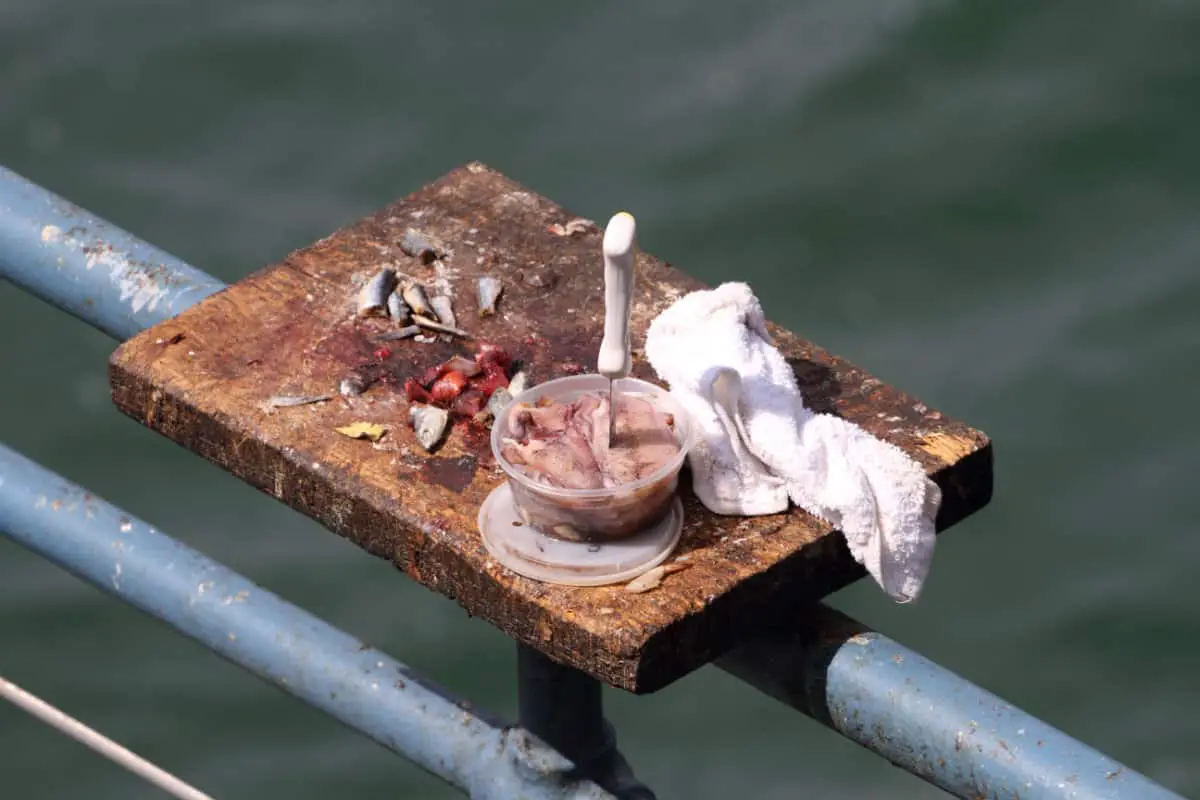
One of the most successful ways you can fish off a pier is to use either live or cut bait. Live bait is hooked on the fishing rod while it is still alive, and its movements and smell are used to attract larger game fish that look for injured prey.
Cut bait, such as chopped up shrimp or squid, is used to provide a scent lure on a fishing rod, but is often used in conjunction with other tackle such as a bucktail![]() or other lure for visual interest and color contrast.
or other lure for visual interest and color contrast.
These are some of the types of bait you can successfully use while pier fishing:
- Baitfish: Pilchard and bunker are two commonly found forms of saltwater baitfish, and both of them are oily fish that have a pungent scent in the water and draw in hungry fish quickly. Hooking a baitfish through the nostrils is the best way to keep the bait alive on the hook while also giving it maximum freedom of movement.
- Clams: Clams (either live or fresh/frozen) are a good bait for many different kinds of saltwater fish, and are an especially good choice for chasing whiting or surfperch. Fresh clams are preferred to dead or frozen ones, as dead clam meat deteriorates quickly, and fresh live clams are easier to keep secure on the hook.
- Shrimp: Shrimp
 can be used either as live bait or can be used as cut bait, either fresh or cooked. Boiling the shrimp slightly can toughen up the flesh and make for a tougher bait that lasts longer on the line. Fresh shrimp does not stay on the hook as well but will be more secure if it is salted before setting on the hook.
can be used either as live bait or can be used as cut bait, either fresh or cooked. Boiling the shrimp slightly can toughen up the flesh and make for a tougher bait that lasts longer on the line. Fresh shrimp does not stay on the hook as well but will be more secure if it is salted before setting on the hook.
- Squid: Squid is often used as cut bait and is convenient because it can be cut to size to fit a variety of hooks; it can also be frozen for later use. Squid is also a tough-fleshed bait, and, if hooked correctly, it can withstand the strikes of more aggressive fish hanging around pier areas.
- Sand fleas: Large sand fleas (also known as mole crabs) can be used as either live bait or can be hooked on the lure as fresh dead bait. Sand fleas have the advantage of being easily foraged on the shore as a source of free bait, and many fish close to the beach go after them as a primary source of food.
It’s important that if you use live bait, keep your bait in a baitwell with aeration to provide oxygen, as bait that has been half-suffocated will be sluggish on the hook and will not hook as many fish as bait that is still lively and wriggling.
Aerating the bait well also ensures that your bait doesn’t die in the live well before you have a chance to use it. You should also use a net with your live well to avoid putting your hands down.
This is because fishing around in the live well by hand not only deposits oils from your hands that are harmful to the baitfish, chasing them by hand is also more stressful and leads to more stress-related baitfish deaths in the live well.
Lures For Pier Fishing
As far as lures go, you have several options you can use depending on what kind of fish you’re trying to go after. Here are a few of the different types of lures you could potentially use:
Spinnerbaits
Spinnerbaits are named for their flashing, spinning metallic blade that moves with a propeller motion, using reflection and vibration to mimic wounded or fleeing prey in the water.
Spinnerbaits are a fantastic choice for chasing predatory game fish such as striped bass or rockfish.
Bucktails
Bucktails are a simple jig lure with a heavy metal or plastic end and a streaming tail that covers the hook end.
Traditionally made with real deer hair, bucktails have expanded to include a variety of synthetic materials such as chenille and plastic flash.
Bucktails are often used in conjunction with live or cut bait.
Spoon lures
Like spinnerbaits, spoon lures are typically metallic (some primitive spoon lures are crafted from a shell) and operate based on reflection to attract a fish to them visually.
Spoon lures also feature randomized jerking movements that mimic the appearance of an injured or dying baitfish. Spoon lures are effective in strong currents.
Jerkbait lures
Jerkbait lures are another kind of lure used to get the attention of predatory fish and imitate the spastic movements of injured baitfish as the rod is drawn up by the fisherman.
These lures are an excellent choice for trying to target large, aggressive types of fish and should be used with a heavy tackle setup.
Buzzbait lures:
Like spinnerbaits and spoon lures, buzz baits are a lure with a blade with several holes drilled in it.
When drawn through the water by a reeling action, the holes in a buzzbait create a thrumming noise in the water and leave a bubble trail that draws the attention from nearby fish from a relatively far distance.
Best Rigs for Pier Fishing
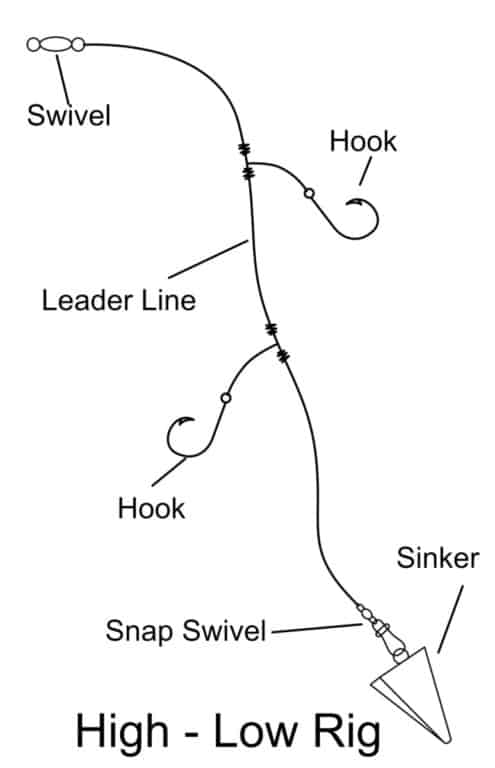
Pier fishing is not the place for ultralight Tackle, and using the right type of rig could make the difference between catching plenty of fish and going home empty-handed.
There’s a lot of rigs to choose from when fishing on a pier. My favorite one is the high-low rig, and I’ve been using it for a long time. I’ve also seen people using a different approach. And it works for them, the key is to try what is working and what is not.
Don’t limit yourself when it comes to rigs. There’s a lot of option you can use, just make sure that you are following the rules in your area.
Another type of rig that you can use for pier fishing is a modified paternoster. This is done by attaching the weight to the very bottom, with a flowing trace put right above it. The distance should be around 3 to 6 feet.
A basic sinker rig can also be used effectively, with a two or four-ounce sinker ![]() that will be large enough to hold it down and a hook size based on the type of fish you are targeting.
that will be large enough to hold it down and a hook size based on the type of fish you are targeting.
The key here is to put your bait in front of the fish you want to catch, and you want to avoid the currents and tides from taking your bait all over the place.
Fish You Can Catch While Pier Fishing
There is a wide variety of fish that can be caught from a pier, from medium-sized panfish to fish, almost too large to be pulled up onto the pier. These are a few of the kinds of fish that can be commonly caught from many piers:
Flounder
Prized for its sweet, mild flesh, this bottom-dwelling ambush predator is fond of inhabiting the ocean floor near the pilings of a pier, dock, or other waterside structure.
Piers attract lots of crabs due to discarded bait and cleaned fish innards that are tossed over the sides, and these crabs, in turn, attract flounders.
Atlantic pompano
Pompano (also known as a “jack” in many areas) is considered one of the most edible saltwater fish and is a popular target of both pier anglers and surf anglers alike.
Pompano is best caught with live shrimp bait or cut bait, and since they have a small mouth, those who want to catch them should use small hooks.
Red drum
Red drum (also known as redfish or channel bass) is a long-lived fish that spend most of their lifespans in coastal waters, which makes them a common catch off of saltwater docks and piers.
Red drum is valued both because of its culinary significance as well as its fighting spirit when hooked on a line.
Sheepshead
The brightly striped sheepshead is an oily fish that must be cooked fresh to taste good but is a popular game fish that is easy to catch from piers.
Sheepshead is primarily known for its teeth, which look uncannily like human teeth. The flesh of the sheepshead is similar to that of a flounder in texture, but more firm.
Bluefish
Bluefish is a dark, oily fish with a coarse flesh that is an aggressive feeder around piers and a hard fighter. Larger bluefish feed on porgies and menhaden, oily baitfish that give their meat a particularly “fishy” flavor.
Smaller bluefish, on the other hand, usually eat more crustaceans and have a milder flavor.
Sharks and rays
Sharks and rays are often caught around piers, as these larger game fish are attracted to the schools of fish that flock to public piers to take advantage of the abundant food there.
In many places, it is illegal to take a shark or a bat ray, and these fish must be released; check your pier fishing area to verify either way.
You can also catch Dungeness crab, surf perch, striped bass and salmon during their season. Make sure to gather all the information you need before you go pier fishing. Each species has different rules and regulations, and this varies in every state.
Water and Weather Conditions for Pier Fishing
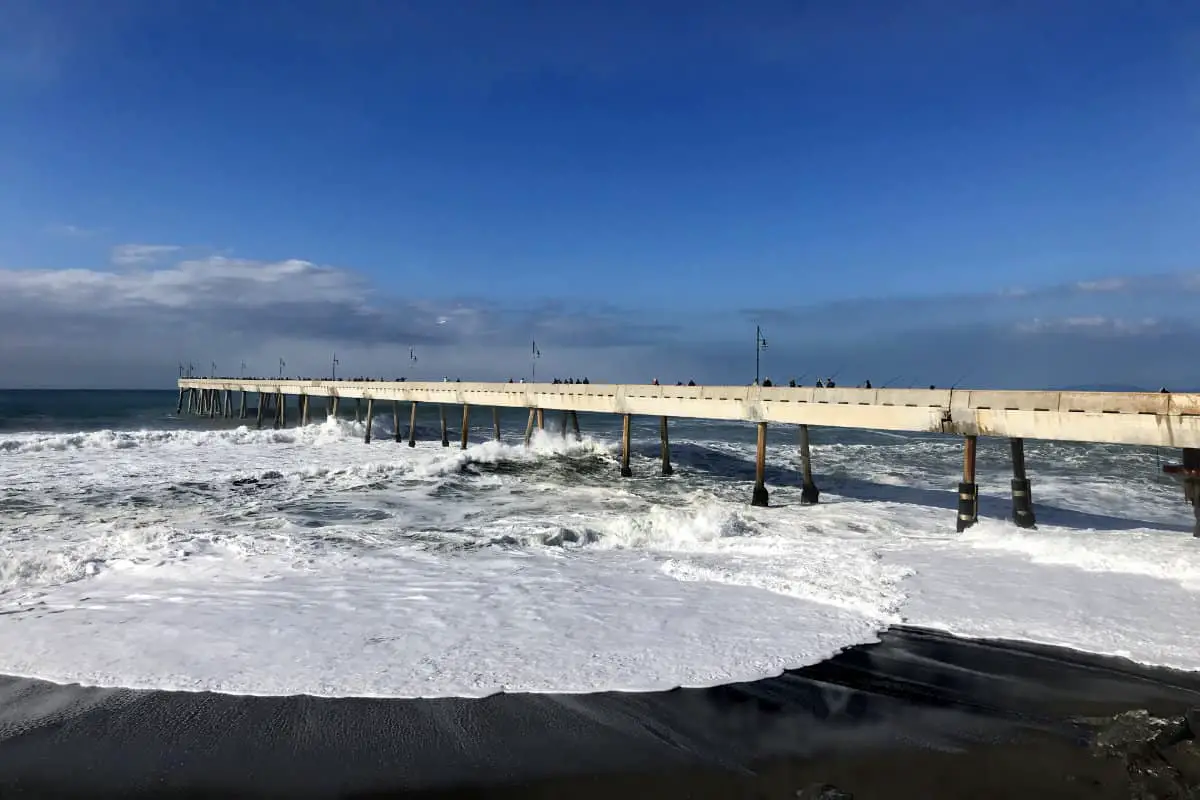
The weather, the clarity of the water, the time of year, the time of day, and how strong the current is are all factors that will determine how active fish are at a pier and which fish will be present.
Different water conditions affect species in different ways, and conditions that will drive some types of fish towards the shore will cause others to head for deeper water.
Here are some of the water and weather conditions you should consider when planning a pier fishing trip:
- Dawn and dusk. Like surf fishing, pier fishing is tide dependent, and the best times for fishing a pier are during the incoming and outgoing tides. This is because tidal motion forces aquatic animals such as baitfish to be on the move, causing larger game fish to become active and feed.
- Look at migratory patterns. Depending on what kind of fish you’re targeting from a pier, different species have seasonal patterns that can cause them to either hug the coastline or head for deep offshore waters. Choosing a time of the year when these fish will be close to shore is crucial to getting a productive catch while pier fishing.
- Look for strong currents. Strong currents occur both closer to a full moon during the lunar cycle and also as a result of storm fronts. Strong currents keep baitfish on the move, which in turn encourages larger game fish to feed actively. Check this article to learn how to read the beach.

Pier Fishing Etiquette
Since pier fishing can get a little crowded during the peaks of the fishing season, it’s essential to be considerate of your fellow anglers whenever you go pier fishing.
Here are some of the rules of pier etiquette you should keep in mind to avoid irritating the fishers around you when you’re on a pier:
- Clean up after yourself. Don’t leave loose hooks or tackle behind for people to step on accidentally, don’t clean your fish anywhere other than the designated fish cleaning stations, don’t leave your trash on the ground for others to have to clean up. Pretty simple stuff.
- Don’t leave your catch on the deck. Dead fish go in a cooler. Live fish go in a live well (or back in the ocean). Saltwater Fish are covered with a mucus slime that can accumulate on the deck of the pier and make it slippery for others to walk on. This is a safety hazard, it makes the pier stink, and it’s gross. Keep your fish appropriately stored.
- Don’t leave fishing rods leaned up against the pier rail. This prevents people from moving around it if they need to chase a fish on the line, but you’re also risking the chance that a large fish will drag it over the side if it’s a tackle shop rental, bad luck for you.
- Watch where you cast. It seems like common sense, but it needs to be said, especially for younger or amateur anglers. Before casting on a pier, check over your shoulder and make sure you aren’t going to be casting into people behind you. One of the biggest risks of getting injured on a pier is being struck by a sharp piece of Tackle and lures.
- If someone is fighting a large or aggressive fish, move out of the way if you can. If you see another angler with a catch, it’s best to pull your cast up and give them some space. That way, they won’t get caught up in what they’re doing and bang into you, and you won’t get in their way and potentially cause them to lose their catch.
- Clean your fish at a fish cleaning station and nowhere else. That’s what the fish cleaning stations are for. Nobody wants to have to wade through fish innards to find a clean spot on the pier to fish, so do your part and make sure fish guts and blood stay in their designated areas.
- If someone offers advice, take it. Someone who bothers to give you some friendly advice while pier fishing likely knows what they’re doing and listening to veteran pier fishers can teach you tips and tricks it would have taken weeks or years to learn. You can also watch more experienced anglers to pick up their techniques.
- Watch over kids if you bring them. Nobody loves a pier fishing trip as many kids, but if you bring a group to the pier, remember everyone else that is fishing at the pier too. Don’t allow children to run up and down the pier unattended, and make sure children are polite and understand the rules about how to cast in close quarters.
- Watch your mouth. It’s easy to start cursing, shouting, and getting caught up in the spirit of things if you hook a big catch, especially if there has been any drinking involved, but remember that children and the elderly often go pier fishing. You don’t want to scandalize anyone. Be polite, and keep your F-bombs to a minimum.
Tips for Pier Fishing
People have been pier fishing for hundreds of years, and regardless of where you do it, the same basic techniques have been applied the world over. These are some of the best tips you can employ to ensure your success while pier fishing:
- Use a heavy pyramid weight on a sandy bottom, not round weight. You’ll want to use the heavy tackle to keep your lure from being tossed by the current. A round weight will only be rolled by the incoming tide, which risks the chance of your tackle getting hopelessly tangled in the pilings beneath the pier and having to be cut loose.
- Look for signs of baitfish activity. If you see a flock of seagulls mobbing the waters near the pier or see cloudy water stirred up, this is an indication of predatory chasing and baitfish activity. Where there are baitfish, larger target fish won’t be far behind.
- Drop, don’t cast. One of the best things about pier fishing is that fish tend to hang out right beneath the pier itself, so you don’t have to cast out far from the pier. You can just drop your lure straight down and have just as much luck without having to worry about casting over a crowded pier.
Pier Fishing is for All Ages
Pier fishing is often used as an introduction to new anglers into this exciting recreational hobby, and with good reason. With just a little planning ahead for supplies and some common courtesy when fishing closely alongside the public, people of all ages and fishing abilities can be very successful fishing off a pier.
Thank you for reading this article. I hope you find it helpful. Good luck on your saltwater fishing journey. Be safe and have fun!
If you’re a beginner and want to learn how to catch Striped bass, Surfperch, and Dungeness crab from the surf, check the links below.

